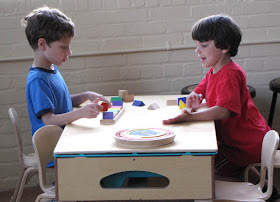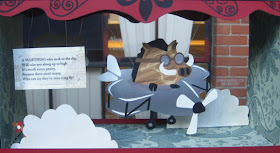This post was contributed by Museum intern Sara Sargent.
Recently in Discovery Studio, I witnessed a young boy’s excitement as he explored bridge building using colorful puzzle blocks.
After forming several shapes with the blocks, he turned to me and asked, “What else can you make with these blocks?” I gave him a few suggestions but he already had his own idea of what he wanted to do. He proclaimed, “I’m going to build a bridge!”
As he played with the blocks, he found that his bridge wouldn’t stay up. I offered a challenge for him to find another material to help support his block bridge. He immediately brought over the triangle blocks from another table and started to stack them, but he said, “It’s kind of hard with the triangles.” I told him that triangles are actually one of the strongest shapes and that engineers use triangles to build bridges in real life. “Oh!” He exclaimed, “I could stack them on top of each other! I’m going to make a pyramid because triangles are strong.”
After placing the triangle blocks on top of each other and realizing that his plan was working, he proclaimed to his mother and siblings who were watching and helping him, “So that’s why they call this the discovery room!”
He placed the last block on the top and placed the original puzzle blocks over the triangles to form the bridge. The bridge held for a little while and then tumbled down, but he had a huge grin on his face. His mother said that it was time to leave the studio. As they left I asked if they had been to the Iway exhibit. The boy excitedly told his mother that he wanted to go there next so he could continue to discover new ways to build bridges.
This moment captures a window into the learning that goes on in an open-ended play environment and how children who visit Discovery Studio understand what it’s all about: discovering through hands-on exploration.
Click here to learn more about Discovery Studio and how it was created.
Sunday, July 31, 2011
Friday, July 22, 2011
All Aboard! (Part II)
 The window boxes in the Museum’s atrium walkway have been transformed into circus cars transporting curious creatures and some seriously silly rhymes.
The window boxes in the Museum’s atrium walkway have been transformed into circus cars transporting curious creatures and some seriously silly rhymes.Limerick Train, a display created by AmeriCorps Museum Educators Jackie Frole and Kerrie Hoban, was inspired by Miriam Troop’s "The Limerick Book: A Collection for Young People." Jackie gave a peek into their process.
Why did you pick this theme?
At the start, Kerrie and I bounced around a lot of ideas, from nursery rhymes to outer space to stuffed animals. We definitely wanted to create some kind of story and began looking in the Museum's library, where we came across Miriam Troop's collection and illustration of limericks. We both fell in love with her cut paper style and the somewhat odd animal poetry. The Limerick Train evolved from that.
How did you choose the limericks?
We chose limericks from the book that were about animals that kids could recognize, but were still clever and humorous. There were a few funny limericks about amoebas and planaria, which we decided against because of their general obscurity. We also had help creating and editing a few limericks. Our friend and writer Matea Mancia created the warthog, chimp, and crocodile limericks for us to use.
Describe your materials and process for creating the scenes.
After settling on our 15 animal limericks, we began collecting wallpaper sample books (generously donated by Adler's Hardware) to use as our material. We really loved the unlimited textures, colors and depth we could create from flat images by working with wallpaper.
For each scene we made a few different sketches and remained flexible when the time came to actually build each box. One example of this was with the newt limerick. We originally had an idea of a sleeping newt in colorful pajamas dreaming about being an accomplished lute player. However, we really wanted to see what a newt would look like as a mime, so that idea won out in the end.
We also had help building some of the boxes from fellow AmeriCorps member, Rachel Schwartz, who offered her creative skills toward building the sad and sneezy rhinoceros.
~ ~ ~ ~ ~
Limerick Train is accompanied by a picture hunt designed by Jackie – see if you can find the worm hiding in each box! – and a challenge to complete this limerick:Have a final line? Leave us a comment, and look for both of the train displays next time you visit the Museum.Nori the dragon peered over the wall,
Atop the Museum, welcoming all,
“Have fun today, kids!”
And he knew that they did,
______________________________
Thursday, July 21, 2011
All Aboard! (Part I)
Two new train-themed displays recently arrived at the Museum!
In the lobby, AmeriCorps Museum Educators Dylan Joy and Sam Ratcliff sent an Amtrak model train traveling through some curious scenes. Dylan described their inspiration:
In our scenes, the train goes from an ordinary town scene through a portal into a world that is unknown: one of large ants, worms, spiders, and flowers that dominate the landscape. It speaks to the possibility of discovering a new world after going through a tunnel or around the bend."
Up next, learn about the Limerick Train that just pulled into the atrium walkway!
In the lobby, AmeriCorps Museum Educators Dylan Joy and Sam Ratcliff sent an Amtrak model train traveling through some curious scenes. Dylan described their inspiration:
"We both enjoy traveling, different landscapes, different cultures. We attempted to create the sensation/phenomenon that occurs while traveling (on a train, in an automobile, by foot, on a bike, etc.), when the traveler is exposed to a new world, a new landscape, a new feeling.
In our scenes, the train goes from an ordinary town scene through a portal into a world that is unknown: one of large ants, worms, spiders, and flowers that dominate the landscape. It speaks to the possibility of discovering a new world after going through a tunnel or around the bend."
Up next, learn about the Limerick Train that just pulled into the atrium walkway!
Monday, July 18, 2011
And the winner is...

Congratulations to Marcela and Yael from Lexington, MA for suggesting Tortellini, the winning name for our Discovery Studio tortoise! And thanks to everyone who entered the contest – there were so many fantastic suggestions, you've left us wanting more pets to name.
We were eager for Tortellini to have a name and, like visitors to Discovery Studio, curious to learn more about tortoises. And so was Tortellini, as it turns out.
 |
| Tortellini "reading" a book about tortoises. (No, this was not staged!) |
So here are some excerpts from our tortoise fact sheet:
What kind of tortoise is Tortellini?
Tortellini is a sulcata tortoise, also known as an African spurred tortoise (Testudinae family). African spurred tortoises are found in hot, dry scrubland areas in a large swath across Northern Africa, south of the Sahara Desert. They live in deep burrows in which they seek refuge from the heat.
How big will he grow?
They grow fast and can grow very big! A tortoise can live over 50 years and its carapace (shell) can grow to be 18 inches across. Tortellini is 2 ½ years old.
What makes a healthy tortoise diet?
Tortoises like to eat grasses (buffalo, bermuda, orchardgrass, little bluestem, and western wheat grass). Tortellini enjoys lettuce leaves and carrot peels. Food treats are strawberries (with greens intact), hollyhock, roses (flowers only), chickweed, dandelions, hibiscus and geranium (leaves and flowers).
What about water?
Once a week, we dip Tortellini in an inch of filtered water and if he’s thirsty, he will drink. Otherwise, he gets all the hydration he needs from food. He is a desert tortoise so he holds all the water he needs in his body.
Thanks to Dave Marchetti of Animal Experiences for providing us with our tortoise and to Marcela and Yael for giving him a name!
Friday, July 15, 2011
We're Honored!
The Museum has been recognized with several wonderful awards recently.
We were honored to receive the Michelle Norris Memorial Award from Children's Friend at their annual meeting – presented to an individual or organization that has provided extraordinary support and/or assistance toward their mission of improving the futures of Rhode Island’s most vulnerable children. The award is presented in memory of Michelle Norris, a Central Falls first grader who was abducted from her neighborhood and murdered over 10 years ago. We were selected in recognition of our service to children and families in need; the Museum partners with Children's Friend through our Families Together program and serves Children's Friend Head Start preschoolers through our AmeriCorps program.
Museum director Janice O'Donnell, upon receiving the award: "Thank you so much for this honor. There are many reasons organizations have for not working together as partners – it's complicated, we're busy, we compete for attention, funds and prestige... But there are many much more important reasons for organizations like ours to work in close partnership – those reasons are the children and families we serve. Children's Friend understands that and is a wonderful partner, always cooperative and helpful, always aware that what's most important is the children. We are so glad to be friends with Children's Friend."
AND we were also recognized twice in the New England Museum Association's Publication Awards Competition, which "recognizes excellence in design, production, and effective communication in all aspects of museum publishing." We won first place for our previous year's annual report and third place for the "Life is a Carnival" gala invitation.
Thanks, Children's Friend and NEMA!
Wednesday, July 6, 2011
Discovery Studio Finishing Touches
We're finally ready to open Discovery Studio tomorrow! Here's a look at what's happened over the past week.
Join us to celebrate the opening of Discovery Studio tomorrow and all weekend! Drop in from 10:00 AM to 4:00 PM to sample a selection of imaginative activities that will be offered throughout the summer. Build with colorful blocks and prisms, create crafts that catch the sun’s rays, and explore the art and science of water, color and light.
We look forward to sharing it with you!
 |
| New sinks were installed, adult and child sized. |
 |
| Graphic Designer Valerie Haggerty-Silva painted the Discovery Studio entryway – the portal, as we've come to know it! |
 |
| Program coordinators Carly Baumann and Mary Scott Hackman began moving materials into the Studio, including program supplies... |
 |
| as well as plenty of artful, inspiring objects to decorate the room. |
 |
| We worked on the initial documentation wall display, which documents the process of creating Discovery Studio. |
 |
| And Exhibit Designer Chris Sancomb and Exhibit Technician Hillel O'Leary installed panels and a canopy to create a cozy nook. |
 |
| Activity supplies are ready to go! |
 |
| A view of the full room - compare to the concept drawing! |
We look forward to sharing it with you!












